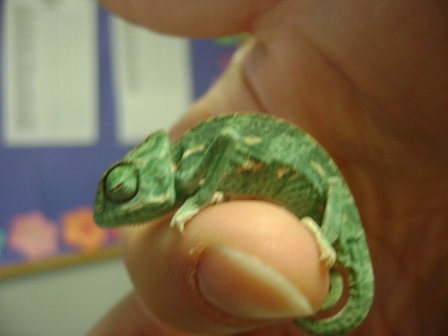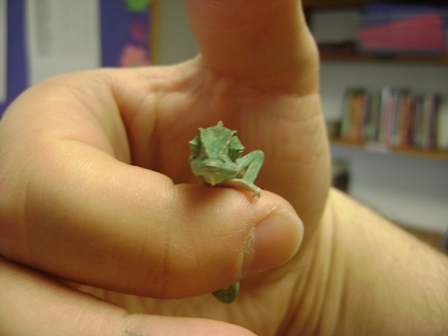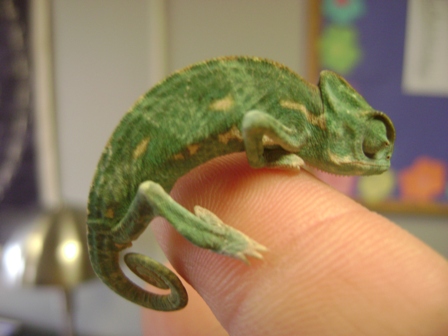I posted in the lizard lounge but now I have pictures. I need to know what kind of chameleon we have and how to save it. It was given to our Boys and Girls Club before I started working here and when I got here this is how I found it. None of us have a clue how to take care of it, but since I have a heart for reptiles, I am taking on the responsibility. He has a wood frame, poly-mesh screen reptarium with a heat emitting light above it. I do not know if it is also a UV bulb. I don't know when the last time he has eaten or drank anything is. I started a drip system in his enclosure three days ago. He had been fed crickets, but I don't know if he ever ate them or if they all escaped. Please help me save this amazing creture.
Navigation
Install the app
How to install the app on iOS
Follow along with the video below to see how to install our site as a web app on your home screen.
Note: This feature may not be available in some browsers.
More options
You are using an out of date browser. It may not display this or other websites correctly.
You should upgrade or use an alternative browser.
You should upgrade or use an alternative browser.
Help
- Thread starter mued2001
- Start date
camimom
New Member
It looks like a veiled chameleon. possibly male, but cant quite tell. if you look at the back of the back feet and you see bumps, that means its a male. It looks like he might also be developing MBD (metabolic bone disease) if you arent sure if he has a uvb light, get one asap. also start supplementing and gutloading your crickets.
A vet trip might be recommended also.
also, read jannb's blog on new chameleon owners. should help alot https://www.chameleonforums.com/hel.../raisingkittytheveiledchameleon.blogspot.com/
A vet trip might be recommended also.
also, read jannb's blog on new chameleon owners. should help alot https://www.chameleonforums.com/hel.../raisingkittytheveiledchameleon.blogspot.com/
Last edited:
That poor little cham is severely dehydrated! You can tell by his eyes sunken into the sockets. Can he even open his eyes at this point? I took in a baby iguana so dehydrated she couldn't even open her eyes. (She's now 15 and still going strong!) One way to try to get him hydrated is putting him on a plant in the shower and aim the shower head at the wall, not at the plant, so that the water bounces off the wall in a mist. The little cham will lick the droplets off the leaves and benefit from the humidity. Make the sure water is only warm, not hot! Leave him in there for about 15-20 minutes, or if he's still drinking then just wait until he's done. That's step one. This may have to be repeated daily to get him hydrated enough. Then read up on some of the info here on the forums to improve his husbandry.
That chameleon is in very sad shape...it needs a lot of help right away.
First of all see if you can get it hydrated. Try misting it gently. Do not spray water directly into its mouth. I see in your other post that you set up a dripper...but it may not be drinking from it. See if you can drip the water on the end of its nose...if might take a few minutes, but hopefully it will drink.
See if it will eat some gutloaded/well fed crickets, small silk worms, small superworms (not meanworms), even a few wax worms (they are fatty and I wouldn't use them often).
Make sure that the chameleon has a UVB light. Make sure that the chameleon can sit within the proper range of the UVB light. Make sure the basking temperature is in the mid to high 80'sF. Since it may have MBD it won't hurt to give it a little extra calcium for a while and even use the phos.-free calcium/D3 powder lighty once a week for a month to give it a boost.
More information.........
Exposure to proper UVB, appropriate temperatures, supplements, a supply of well-fed/gutloaded insects, water and an appropriate cage set-up are all important for the well-being of your chameleon.
Appropriate cage temperatures aid in digestion and thus play a part indirectly in nutrient absorption. Temperatures needed can vary with the species.
Exposure to UVB from either direct sunlight or a proper UVB light allows the chameleon to produce D3 so that it can use the calcium in its system to make/keep the bones strong and be used in other systems in the chameleon as well. The UVB should not pass through glass or plastic no matter whether its from the sun or the UVB light. The most often recommended UVB light is the long linear fluorescent Repti-sun 5.0 tube light. Some of the compacts, spirals and tube lights have caused health issues, but so far there have been no bad reports against this one.
Since many of the feeder insects have a poor ratio of calcium to phosphorus in them, its important to dust the insects just before you feed them to the chameleon at most feedings with a phos.-free calcium powder to help make up for it. (I use Rep-cal phosphorus-free calcium).
If you also dust twice a month with a phos.-free calcium/D3 powder it will ensure that your chameleon gets some D3 without overdoing it. It leaves the chameleon to produce the rest of what it needs through its exposure to the UVB light. D3 from supplements can build up in the system but D3 produced from exposure to UVB shouldn't as long as the chameleon can move in and out of it. (I use Rep-cal phos.-free calcium/D3).
Dusting twice a month as well with a vitamin powder that contains a beta carotene (prOformed) source of vitamin A will ensure that the chameleon gets some vitamins without the danger of overdosing the vitamin A. PrEformed sources of vitamin A can build up in the system and may prevent the D3 from doing its job and push the chameleon towards MBD. However, there is controversy as to whether all/any chameleons can convert the beta carotene and so some people give some prEformed vitamin A once in a while. (I use herptivite.)
Gutloading/feeding the insects well helps to provide what the chameleon needs. I gutload crickets, roaches, locusts, superworms, etc. with an assortment of greens (dandelions, kale, collards, endive, escarole, mustard greens, etc.) and veggies (carrots, squash, sweet potato, sweet red pepper, zucchini, etc.)
Calcium, phos., D3 and vitamin A are important players in bone health and other systems in the chameleon (muscles, etc.) and they need to be in balance. When trying to balance them, you need to look at the supplements, what you feed the insects and what you feed the chameleon.
Here are some good sites for you to read...
http://chameleonnews.com/07FebWheelock.html
http://web.archive.org/web/200605020...Vitamin.A.html
http://web.archive.org/web/200406080...d.Calcium.html
http://www.uvguide.co.uk/
http://raisingkittytheveiledchameleon.blogspot.com/
http://web.archive.org/web/200601140...ww.adcham.com/
If the sites that have the word "archive" in don't work, you should be able to get to them by using the WayBackMachine.
First of all see if you can get it hydrated. Try misting it gently. Do not spray water directly into its mouth. I see in your other post that you set up a dripper...but it may not be drinking from it. See if you can drip the water on the end of its nose...if might take a few minutes, but hopefully it will drink.
See if it will eat some gutloaded/well fed crickets, small silk worms, small superworms (not meanworms), even a few wax worms (they are fatty and I wouldn't use them often).
Make sure that the chameleon has a UVB light. Make sure that the chameleon can sit within the proper range of the UVB light. Make sure the basking temperature is in the mid to high 80'sF. Since it may have MBD it won't hurt to give it a little extra calcium for a while and even use the phos.-free calcium/D3 powder lighty once a week for a month to give it a boost.
More information.........
Exposure to proper UVB, appropriate temperatures, supplements, a supply of well-fed/gutloaded insects, water and an appropriate cage set-up are all important for the well-being of your chameleon.
Appropriate cage temperatures aid in digestion and thus play a part indirectly in nutrient absorption. Temperatures needed can vary with the species.
Exposure to UVB from either direct sunlight or a proper UVB light allows the chameleon to produce D3 so that it can use the calcium in its system to make/keep the bones strong and be used in other systems in the chameleon as well. The UVB should not pass through glass or plastic no matter whether its from the sun or the UVB light. The most often recommended UVB light is the long linear fluorescent Repti-sun 5.0 tube light. Some of the compacts, spirals and tube lights have caused health issues, but so far there have been no bad reports against this one.
Since many of the feeder insects have a poor ratio of calcium to phosphorus in them, its important to dust the insects just before you feed them to the chameleon at most feedings with a phos.-free calcium powder to help make up for it. (I use Rep-cal phosphorus-free calcium).
If you also dust twice a month with a phos.-free calcium/D3 powder it will ensure that your chameleon gets some D3 without overdoing it. It leaves the chameleon to produce the rest of what it needs through its exposure to the UVB light. D3 from supplements can build up in the system but D3 produced from exposure to UVB shouldn't as long as the chameleon can move in and out of it. (I use Rep-cal phos.-free calcium/D3).
Dusting twice a month as well with a vitamin powder that contains a beta carotene (prOformed) source of vitamin A will ensure that the chameleon gets some vitamins without the danger of overdosing the vitamin A. PrEformed sources of vitamin A can build up in the system and may prevent the D3 from doing its job and push the chameleon towards MBD. However, there is controversy as to whether all/any chameleons can convert the beta carotene and so some people give some prEformed vitamin A once in a while. (I use herptivite.)
Gutloading/feeding the insects well helps to provide what the chameleon needs. I gutload crickets, roaches, locusts, superworms, etc. with an assortment of greens (dandelions, kale, collards, endive, escarole, mustard greens, etc.) and veggies (carrots, squash, sweet potato, sweet red pepper, zucchini, etc.)
Calcium, phos., D3 and vitamin A are important players in bone health and other systems in the chameleon (muscles, etc.) and they need to be in balance. When trying to balance them, you need to look at the supplements, what you feed the insects and what you feed the chameleon.
Here are some good sites for you to read...
http://chameleonnews.com/07FebWheelock.html
http://web.archive.org/web/200605020...Vitamin.A.html
http://web.archive.org/web/200406080...d.Calcium.html
http://www.uvguide.co.uk/
http://raisingkittytheveiledchameleon.blogspot.com/
http://web.archive.org/web/200601140...ww.adcham.com/
If the sites that have the word "archive" in don't work, you should be able to get to them by using the WayBackMachine.
Last edited:
jannb
Chameleon Enthusiast
I was just able to get it to drink until it was full by dripping the water right on the tip of its nose. I am going to get a proper mister now. I will be gone for the weekend. Its light is on a timer; will it make it until Monday?
Probably not if you leave it alone. He needs allot of care right now. Where do you live maybe a forums member will keep him for you.
krknieriem
New Member
Even healthy chams require daily care, you really should take him home with you and follow the instructions that people have given you here if you want him to have any chance of survival.
Similar threads
- Replies
- 89
- Views
- 4K









